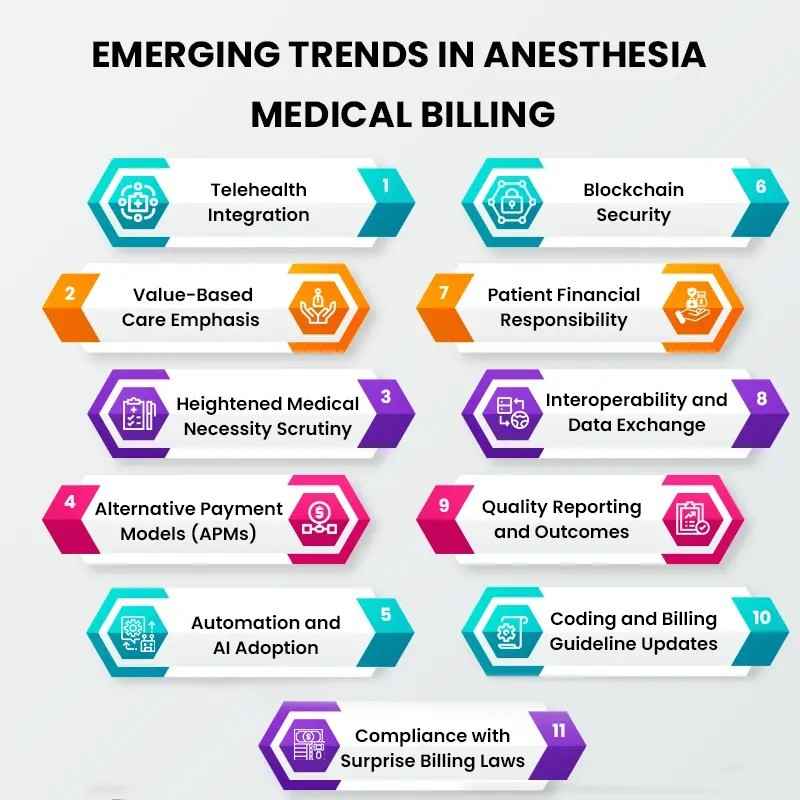Whether you are an expert Anesthesiologist, a medical coder, or a healthcare administrator, our guidelines will equip you with the knowledge and tools needed to streamline the Anesthesia Billing process, reduce claim denials, enhance Revenue Cycle Management, and ultimately, provide better patient care. This blog will be a comprehensive resource for healthcare professionals seeking clarity in Anesthesia Medical Billing. We will explore everything from the fundamental concepts of Anesthesia Coding to the importance of accurate documentation and insurance reimbursements.
Anesthesia is a standard medical practice for Anesthesia practitioners to examine and evaluate patients before surgery. The Anesthesia service is included in the base unit value of the Anesthesia Medical Billing Code. The evaluation and examination are not registered during the Anesthesia time. If surgery is cancelled, payment may be allowed to the Anesthesiologist for an Evaluation and Management (E/M) service after the pre-operative evaluation, and the appropriate E/M code may be reported.
Similarly, regular post-operative evaluation is included in the base unit for the Anesthesia service. If this evaluation happens after the Anesthesia practitioner safely places the patient under post-operative care, the additional Anesthesia time units or E/M codes shall not be reported for this evaluation. Post-operative E/M services related to the surgery are not reportable separately by the Anesthesia practitioner except when an Anesthesiologist provides identifiable continued critical care services separately. If permitted by state law, Anesthesia practitioners may separately report recognizable post-operative management services after the Anesthesia service time ends. Post-operative pain management and ventilator management are unrelated to the Anesthesia procedure.
Anesthesia medical services can be more difficult than a surgeon or hospital charges. While accurate documentation is essential to Anesthesia Medical Billing, compliance, and reimbursement for every type of healthcare specialist. The process can prove more complex for Anesthesia Management Solutions compared to other providers.
For example, Surgeons only have to use a single CPT code to cover overall necessary services from pre-op to post-op. On the other hand, Anesthesia Medical Billing and Coding is more complex. Anesthesia Billing Services are uniquely calculated based on the following criteria.
Base Units: These recall the complexity of the surgical procedure. Each procedure has a related code with a base unit value. More difficult practices requiring higher skill will have a higher base unit.
Time Units: They are usually 15 minutes long, but the valuation can change by contract. Time calculation occurs while the physician assumes patient care, remains in attendance caring for the patient, and continues until the patient is no longer supervised and the report has been completed.
Modifying Units: Emergencies and specific conditions in a patient’s health are considered modifying units.
Conversion Factor: Distinctive to the provider’s location, this cost is assigned to each unit.
Anesthesia Billing Services include but are unlimited to a pre-operative evaluation of the patients, administration of Anesthetic, other medications, blood and fluids, monitoring physiological parameters, and other supportive services.
Anesthesia Medical Billing describes a general anatomic area or service which usually connects to several surgical procedures.
Any claim for a healthcare service must define what service/procedure was performed and why it was done. Modifiers refer to the two-character indicators that support identifying relevant details on a claim. Modifiers and Codes are essential to improve accuracy in reimbursement and coding consistency. They also help to avoid duplicate Anesthesia Billing and unbundling.
The Healthcare Common Procedure Coding System (HCPCS) code set indicates modifiers specific to Anesthesia care and needed on claims submitted to healthcare and many other payers.
The global period refers to the time frame that covers the necessary services a surgeon performs during the pre-operative, intra-operative, and post-operative stages of a procedure. It also includes any essential services performed by that surgeon’s team members. These services are included in the reimbursement of the actual surgery, and they cannot be reported separately. Under the global surgery rule, all surgical procedures are grouped into a single claim. Understanding the specifics of the global surgery process is essential to ensure maximum reimbursement for your Anesthesia Management Solutions rendered.
Modifiers are necessary because they provide additional information and details concerning a service provided by an Anesthesiologist. Modifiers help further represent a procedure by clarifying whether a service was medically directed, personally performed, or medically supervised by an Anesthesiologist. These Modifiers in Anesthesia Management Solutions are required to process a claim, so accuracy is compulsory. Some Examples of HCPCS Modifiers used in Anesthesia Billing Services and Coding are:
Anesthesia Medical Billing procedure codes define a general anatomic area or service, which usually connects to several surgical procedures. While paying most payers, only one Anesthesia code is registered unless the Anesthesia code is an Add-on Code (AOC).
The Current Procedural Terminology (CPT®) code range 00100 to 01860 specifies ‘Anesthesia for’ followed by a definition of a surgical intervention.
The CPT code range 01916 to 01942 describes Anesthesia for radiological practices.
The CPT code range 01951 to 01999 describes Anesthesia services for burn debridement/excision, obstetrical, and other practices.
The CPT code range 99151 to 99157 describes moderate (conscious) sedation services. CPT codes 01935 and 01936 were deleted as of January 1, 2022.
A unique characteristic of Anesthesia Medical Billing Coding is the reporting of time units. Payment for Anesthesia Billing Services increases with time. In addition to reporting a base unit value for an Anesthesia Billing Service, the Anesthesia practitioner notifies Anesthesia time. Anesthesia time is described as the period during which an Anesthesia practitioner is present with the patient. It starts when the Anesthesia practitioner begins to schedule the patient for Anesthesia services in the operating room and finishes when the Anesthesia practitioner is no longer providing Anesthesia services to the patient (i.e., when the patient may be placed safely under postoperative care).
Anesthesia procedure is a continuous period from the start to the end of an Anesthesia service. In counting Anesthesia time, the Anesthesia practitioner can add blocks of time around an interruption in Anesthesia time as long as the practitioner provides continuous Anesthesia care within the time periods around the interruption. However, if it is medically required for the Anesthesia practitioner to continually monitor the patient during the break time and not perform any other service, the interval time may be added to the Anesthesia time.
To be reimbursed for Anesthesia Billing Services, you must bill insurance companies.
Anesthesia is calculated at an estimated time of 15-minute intervals (15 x 4 = 60). Insurance companies reimburse for Anesthesia Billing Services with Codes and Modifiers by the guidelines provided by The Centers for Medicare & Medicaid Services (CMS) and state guidelines/regulations.
Regular auditing will help to educate staff on regulatory submission. When everyone follows suitable procedures with accuracy, you can achieve your goal of better efficiency, optimized revenue, and safe, high quality patient care.
Emerging trends in Anesthesia Medical Billing are continually reshaping the landscape of healthcare revenue management. Staying updated with these trends is essential for Anesthesia Management Solutions, Anesthesia Billing professionals, and healthcare administrators. Here are some notable emerging trends in Anesthesia Billing Services:
Telehealth Integration: Telehealth has become more prevalent, requiring Anesthesia Medical Billing providers to adapt their billing practices for remote consultations and assessments.
Value-Based Care Emphasis: The shift toward value-based care and bundled payments means Anesthesia Billing Services must focus on quality and cost-efficiency.
Heightened Medical Necessity Scrutiny: Payers are closely reviewing the medical necessity of Anesthesia Billing Services, necessitating accurate Documentation and Coding.
Alternative Payment Models (APMs): Participation in APMs like (Accountable Care Organization) ACOs is increasing, and Anesthesia Management Solutions may need to adjust their billing strategies accordingly.
Automation and AI Adoption: Automation and AI are streamlining billing processes, reducing errors, and improving efficiency, particularly in error identification and Revenue Cycle Management.
Blockchain Security: Blockchain technology is being explored for enhanced security and transparency in Anesthesia Medical Billing, preventing fraud and ensuring data integrity.
Patient Financial Responsibility: Patients bear more healthcare costs, so Anesthesia Billing providers should facilitate patient billing and collections effectively.
Interoperability and Data Exchange: Improved data exchange between healthcare systems and payers is streamlining billing, reducing administrative burdens, and enhancing accuracy.
Quality Reporting and Outcomes: Participation in quality reporting programs is vital to demonstrate service quality and safety, impacting reimbursement rates and payer contracts.
Coding and Billing Guideline Updates: Anesthesia Management Solutions providers should stay current with changes in CPT codes and Anesthesia Billing guidelines to ensure accurate billing.
Compliance with Surprise Billing Laws: New legislation seeks to protect patients from surprise out-of-network charges, necessitating compliance adjustments and awareness of Anesthesia Medical Billing implications.
These emerging trends require Anesthesia Management Solutions providers and Anesthesia Medical Billing teams to stay informed and proactive in adapting their practices to navigate these changes effectively.
Anesthesia Medical Billing for Anesthesia is a challenging feat. Most importantly, you must hire an Anesthesia Medical Billing and Coding expert to maximize eligible revenue from your Anesthesia Billing Services. Whether it is in-house or outsourced, it will ensure you get the most out of your claims and decrease overhead expenses in the process.








